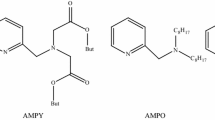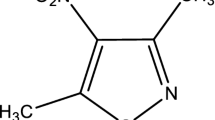Abstract
The standard (p o = 0.1 MPa) molar energies of combustion, \( \Updelta_{\text{c}} H_{\text{m}}^{\text{o}} \), for indole-2-carboxylic acid and indole-3-carboxaldehyde, in the crystalline state, were determined, at T = 298.15 K, using a static bomb combustion calorimeter. For both compounds, the vapour pressures as function of temperature were measured, by the Knudsen effusion technique, and the standard molar enthalpies of sublimation, \( \Updelta_{\text{cr}}^{\text{g}} H_{\text{m}}^{\text{o}} \), at T = 298.15 K, were derived by the Clausius–Clapeyron equation. From the experimental results, the standard (p o = 0.1 MPa) molar enthalpies of formation in the condensed and gaseous phases, at T = 298.15 K, of indole-2-carboxylic acid and indole-3-carboxaldehyde were derived. The results are analysed in terms of structural enthalpic increments.


Similar content being viewed by others
References
Lee S, Yang Yi K, Kim S, Suh J, Kim NJ, Yoo S, Lee BH, Seo HW, Kim S, Lim H. Cardioselective anti-ischemic ATP-sensitive potassium channel (KATP) openers: benzopyranyl indoline and indole analogues. Eur J Med Chem. 2003;38:459–71.
Noguchi T, Tanaka N, Nishimata T, Goto R, Hayakawa M, Sugidachi A, Ogawa T, Asai F, Matsui Y, Fujimoto K. Indoline derivatives I: synthesis and factor Xa (FXa) inhibitory activities. Chem Pharm Bull. 2006;54:163–74.
Hür D, Güven A. The acidities of some indoles. J Mol Struct (Theochem). 2002;1:18–9.
Ribeiro da Silva MAV, Cabral JITA, Gomes JRB. Experimental and computational study on the molecular energetics of indoline and indole. J Phys Chem A. 2008;112:12263–9.
Ribeiro da Silva MAV, Cabral JITA, Gomes JRB. Combined experimental and computational study of the energetics of methylindoles. J Chem Thermodyn. 2009;41:1193–8.
Ribeiro da Silva MAV, Cabral JITA. Experimental thermochemical study of 5-bromoindole and 5-bromoindoline. J Chem Thermodyn. 2009;41:84–9.
Ribeiro da Silva MAV, Cabral JITA. Experimental study on the thermochemistry of 5-nitroindole and 5-nitroindoline. J Chem Thermodyn. 2009;41:355–60.
Smith DH, Okiyama K, Thomas MJ, McIntosh TK. Effects of the excitatory amino acid receptor antagonists kynurenate and indole-2-carboxylic acid on behavioral and neurochemical outcome following experimental brain injury. J Neurosci. 1993;13:5383–92.
Nagata S, Takeyama K, Fukuya F, Nagai R, Hosoki K, Nishimura K, Deguchi T, Karasawa T. Antihypertensive properties of a new long-acting angiotensin converting enzyme inhibitor in renin-dependent and independent hypertensive models. Arzneimittel-Forschung/Drug Res. 1995;14:853–8.
Vlasova MI, Kogan NA, Lesiovskaya YY, Pastushenkov LV. Synthesis and biological activity of 1-aryl-2-oxa-5-aza-5r1–6-oxocyclooctano[6,7-b]indoles. Pharm Chem J. 1992;26:492–6.
Nichols AC, Yielding KL. Anticonvulsant activity of antagonists for the NMDA-associated glycine binding site. Mol Chem Neuropathol. 1993;19:269–82.
Mugnaini M, Antolini M, Corsi M, Vanamsterdam FT. [3H]5,7-dichlorokynurenic acid recognizes two binding sites in rat cerebral cortex membranes. J Recept Signal Transduct Res. 1998;18:91–112.
Kipp C, Young AR. The soluble eumelanin precursor 5,6-dihydroxyindole-2-carboxylic acid enhances oxidative damage in human keratinocyte DNA after UVA irradiation. Photochem Photobiol. 1999;70:191–8.
Kutschy P, Dzurilla M, Takasugi M, Sabova A. Synthesis of some analogs of indole phytoalexins brassinin and methoxybrassenin B and their positional isomers. Coll Czech Chem Commun. 1999;64:348–62.
Gurkok G, Altanlar N, Suzen S. Investigation of antimicrobial activities of indole-3-aldehyde hydrazide/hydrazone derivatives. Int J Exp Clin Chemother. 2009;55:15–9.
Sinha D, Tiwari AK, Singh S, Shukla G, Mishra P, Chandra H, Mishra AK. Synthesis, characterization and biological activity of Schiff base analogues of indole-3-carboxaldehyde. Eur J Med Chem. 2008;42:160–5.
Gundry HA, Harrop D, Head AJ, Lewis GB. Thermodynamic properties of organic oxygen compounds 21. Enthalpies of combustion of benzoic acid, pentan-1-ol, octan-1-ol, and hexadecan-1-ol. J Chem Thermodyn. 1969;1:321–32.
Bickerton J, Pilcher G, Al-Takhin G. Enthalpies of combustion of the three aminopyridines and the three cyanopyridines. J Chem Thermodyn. 1984;16:373–8.
da Silva MDMCR, Santos LMNBF, Silva ALR, Fernandes O, Acree WE Jr. Energetics of 6-methoxyquinoline and 6-methoxyquinoline N-oxide: the dissociation enthalpy of the (N–O) bond. J Chem Thermodyn. 2003;35:1093–100.
Certificate of Analysis Standard Reference Material 39j Benzoic Acid Calorimetric Standard. Washington, DC: NBS; 1995.
Santos LMNBF, Silva MT, Schröder B, Gomes L. J Therm Anal Calorim. 2007;89:175–80.
Copps J, Jessup RS, Van Nes K. Calibration of calorimeters for reactions in a bomb at constant volume. In: Rossini FD, editor. Experimental Thermochemistry, vol. 1. Chapter 3. New York: Interscience; 1956.
Wagmam DD, Evans WH, Parker VB, Shum RH, Halow I, Bailey SM, Kenneth LC, Nuttal RL. The NBS tables of chemical thermodynamic properties. J Phys Chem Ref Data. 1982;11(2):2–12.
Washburn EW. Standard states for bomb calorimetry. J Res Nalt Bur Stand (US). 1933;10:525–58.
Hubbard WN, Scott DW, Waddington G. Standard states and corrections for combustions in a bomb at constant volume. In: Rossini FD, editor. Experimental thermochemistry, vol. 1. Chapter 5. New York: Interscience; 1956.
Yaws CL, Chen DH. Density of solid—organic compounds. In: Yaws CL, editor. Thermophysical properties of chemicals and hydrocarbons, vol. Chapter 5. Beaumont: William Andrew Inc.; 2008.
http://www.lookchem.com, “lookchem”–look for chemicals. Accessed September 2012.
Wieser ME, Coplen TP. Atomic weights of the elements 2009 (IUPAC Technical Report). Pure Appl Chem. 2011;83:359–96.
Ribeiro da Silva MAV, Monte MJS, Santos LMNB. The design, construction, and testing of a new Knudsen effusion apparatus. J Chem Thermodyn. 2006;38:778–87.
Cox JD, Wagman DD, Medvedev VA. CODATA key values for thermodynamics. New York: Hemisphere; 1989.
Rossini FD. Assignment of uncertainties to thermochemical data. In: Rossini FD, editor. Experimental thermochemistry, vol. 1, Chapter 14. New York: Interscience; 1956.
Olofson G. Assignment of uncertainties. In: Sunner S, Månsson M, editors. Combustion calorimetry, vol. Chapter 1. Oxford: Pergamon; 1979.
Chickos JS, Hossini S, Hesse DG, Liebman JF. Heat capacity corrections to a standard state: a comparison of new and some literature methods for organic liquids and solids. Struct Chem. 1993;4:271–8.
Chickos JS, Hesse DG, Liebman JF. A group additivity approach for the estimation of heat capacities of organic liquids and solids at 298 K. Struct Chem. 1993;4:261–9.
Hubbard WN, Scott DW, Frow FR, Waddington G. Thiophene: heat of combustion and chemical thermodynamic properties. J Am Chem Soc. 1955;77:5855–7.
Temprado M, Roux MV, Jiménez P, Dávalos JZ, Notario R. Experimental and computational thermochemistry of 2- and 3-thiophenecarboxylic acids. J Phys Chem A. 2002;106:11173–80.
Ribeiro da Silva MAV, Santos AFLOM. Energetics of thiophenecarboxaldehydes and some of its alkyl derivatives. J Chem Thermodyn. 2008;40:917–23.
Pedley JB. Thermochemical data and structures of organic compounds. Thermodynamics Research Center, College Station: CRC; 1994.
Roux MV, Temprado M, Jiménez P, Dávalos JZ, Notario R. Thermochemistry of furancarboxylic acids. J Phys Chem A. 2003;107:11460–71.
Ribeiro da Silva MAV, Amaral LMPF. Standard molar enthalpies of formation of 2-furancarbonitrile, 2-acetylfuran, and 3-furaldehyde. J Chem Thermodyn. 2009;41:26–9.
Scott DW, Berg WT, Hossenlopp IA, Hubbard WN, Messerly JF, Todd SS, Douslin DR, McCullough JP, Waddington G. Pyrrole: chemical thermodynamic properties. J Phys Chem. 1967;71:2263–70.
Santos AFLOM, Ribeiro da Silva MAV. Experimental and computational study on the molecular energetics of 2-pyrrolecarboxylic acid and 1-methyl-2-pyrrolecarboxylic acid. J Phys Chem A. 2009;113(9741):50.
Santos AFLOM, Ribeiro da Silva MAV. A combined experimental and computational thermodynamic study of the isomers of pyrrolecarboxaldehyde and 1-methyl-pyrrolecarboxaldehyde. J Phys Chem B. 2011;115:12549–57.
Acknowledgements
Thanks are due to Fundação para a Ciência e Tecnologia (FCT), Lisbon, Portugal and to FEDER for financial support given to Centro de Investigação em Química da Universidade do Porto and to Programa Ciência 2008 (PEst-C/QUI/UI0081/2011). Joana I. T. A. Cabral thanks FCT for the award of a Post-Doc research grant (SFRH/BPD/64735/2009).
Author information
Authors and Affiliations
Corresponding author
Rights and permissions
About this article
Cite this article
Amaral, L.M.P.F., de Carvalho, T.M.T., Cabral, J.I.T.A. et al. Experimental study on the energetics of two indole derivatives. J Therm Anal Calorim 115, 803–810 (2014). https://doi.org/10.1007/s10973-013-3332-8
Received:
Accepted:
Published:
Issue Date:
DOI: https://doi.org/10.1007/s10973-013-3332-8




